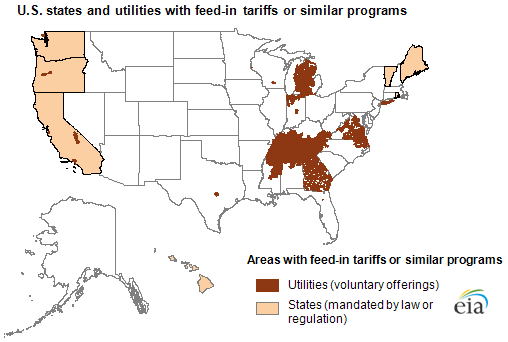Feed-in tariff: A policy tool encouraging deployment of renewable electricity technologies

Source: U.S.
Energy Information Administration and Energy Velocity.
Feed-in tariffs (FITs) are a policy mechanism used to encourage deployment of renewable electricity technologies. A FIT program typically guarantees that customers who own a FIT-eligible renewable electricity generation facility, such as a roof-top solar photovoltaic system, will receive a set price from their utility for all of the electricity they generate and provide to the grid.
FITs, or similarly structured programs, are mandated to varying degrees in a limited number of states. However, a different model has also emerged in which utilities independently establish a utility-level FIT, either voluntarily or in response to state or local government mandates.
In a recent example, Dominion Virginia Power's voluntary FIT for residential and commercial solar photovoltaic (PV) generators was approved by the Virginia State Corporation Commission in March 2013. Participants will receive 15 cents/kilowatthour (kWh) for a contract term of five years for all PV-generated electricity provided to the grid, and will continue to pay the retail rate for all electricity that they consume. Virginia's average 2012 retail electricity price was 10.5 cents/kWh for residential customers and 7.8 cents/kWh for commercial customers.
Comparison with other policy tools
Other types of policies encouraging development of new renewable capacity that are more commonly used in the United States include:
- Rebates for purchasing renewable generation equipment
- Renewable portfolio standards (RPS)
- Net metering
- Tax incentives (production- or investment-based) such as the federal wind production tax credit
Variations on feed-in tariff policies
In general, feed-in tariff rates that lead to significant additional renewable energy investment are set above the retail cost of electricity. In a recent example, in 2012 Japan implemented a new FIT with particularly high PV tariff rates (more than 40 cents/kWh) as part of its post-Fukushima policy.
However, without additional controls, generous FIT levels can lead to more investment than intended. One illustration is the Spanish experience, in which the government significantly reduced the tariff a year after its start, and suspended the FIT altogether in 2012, to contain costs to the government and other utility customers.
Rate and contract terms—Excluding some experimental programs, most U.S. contracts are long term (10-20 years). This assures project owners of a stable long term revenue stream. Utilities often set rates that depend on project size (smaller projects tend to receive higher rates) and technology (solar PV tends to receive higher rates than other technologies). Rates can also depend on the overall program goal or size limits (e.g., tariffs that decrease as capacity approaches the program ceiling), and utilities or states may revise their tariffs in cases of over- or under-subscription.
System size and sector restrictions—Most U.S. FIT programs have a maximum size for individual projects and may limit participation to certain sectors, like residential customers. The new Dominion Virginia Power Solar Purchase Program, for example, applies only to residential systems up to 20 kilowatts (kW) and commercial systems up to 50 kW in size, while Hawaii's FIT, which applies to all of Hawaii's investor-owned utilities, has a maximum system size ranging from 2,700 kW to 5,000 kW, depending on the island.
Program size limitations—Most U.S. programs designate a cumulative ceiling, set either annually or at the program level, capping the amount of capacity that can take advantage of the tariff. This is an important cost containment mechanism for FIT programs. (DOE-EIA)
No comments:
Post a Comment